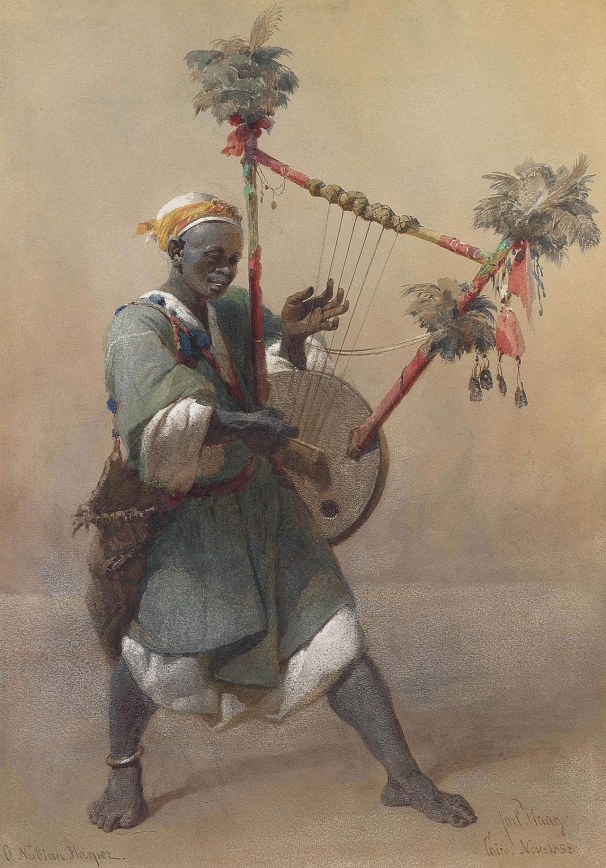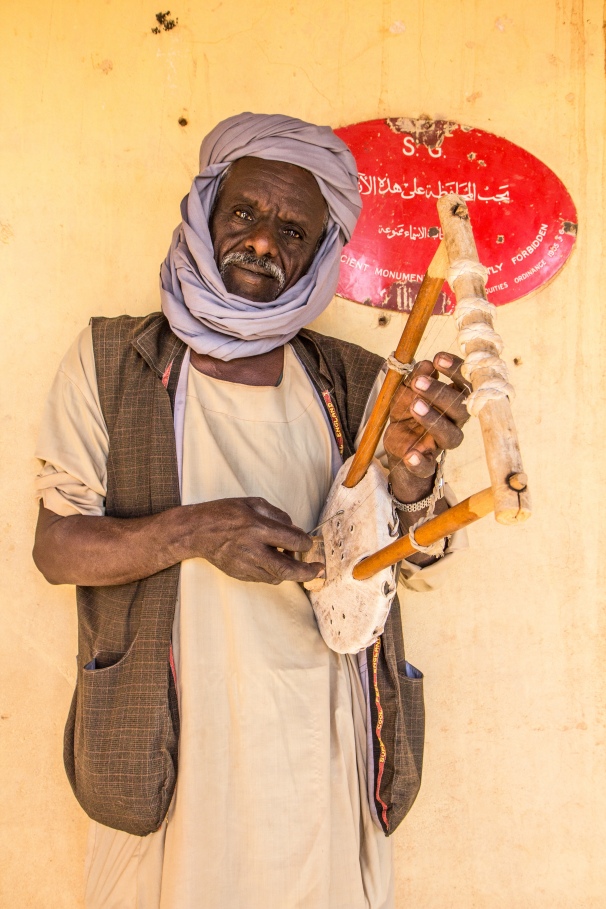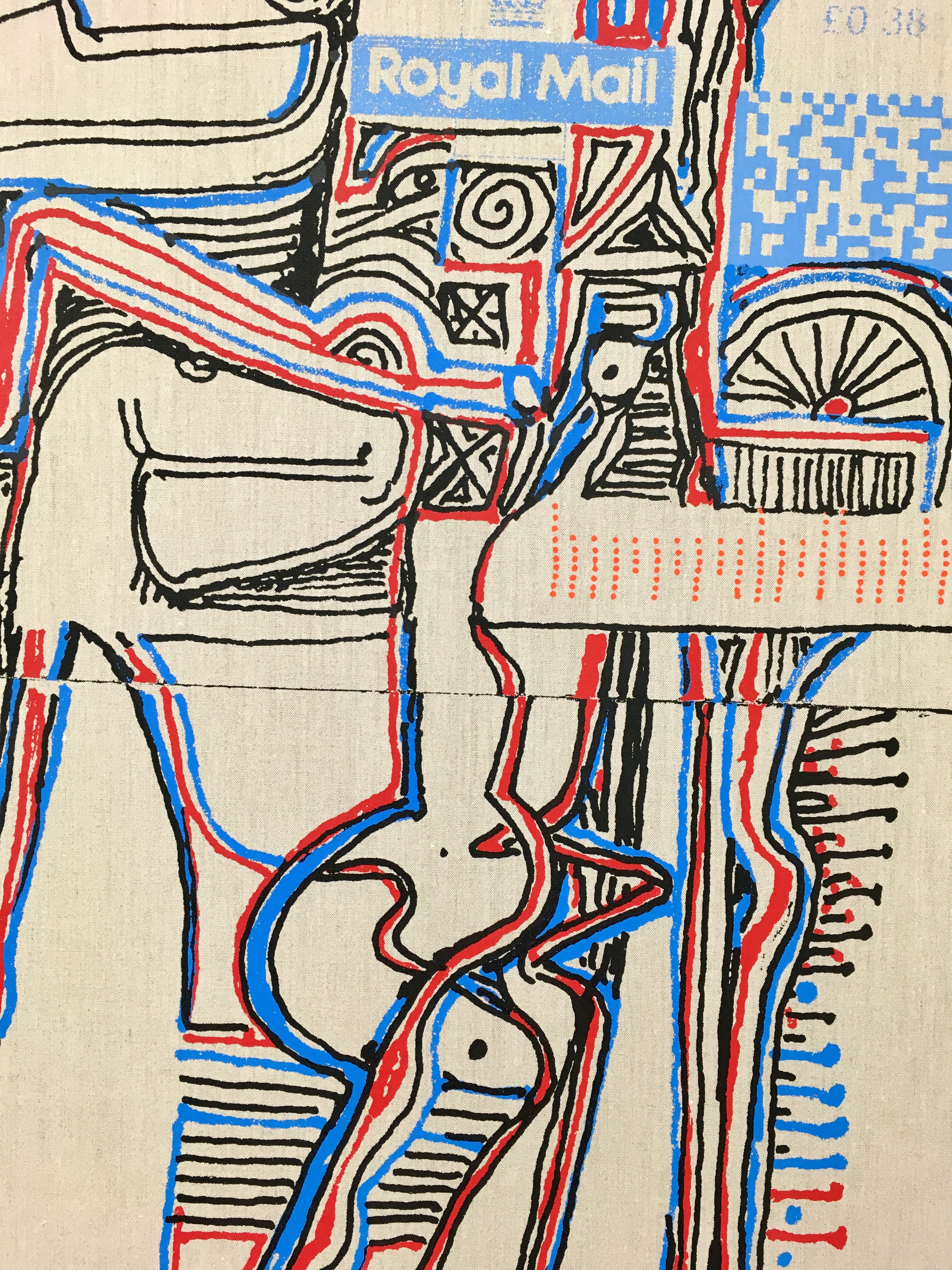
Title photo and above, a 19th century Sudanese lyre or tanbūra / tanbūr or rababa, known in Northern Sudan as kissar, from the Nubian word ko:s (bowl), also used to refer to the cavity of the skull. The lyre belongs to The British Museum’s Sudan Collection. The photos of this lyre are copyright,Trustees British Museum, and are reproduced here under CC licence for non-commercial use.
A lucent corset of trade beads and cowrie shells sheaves its “outstretched arms”, interwoven with hanging tokens and talismans, prayer beads and coins, bells and leather amulets. The wooden bowl-shaped resonator, or “skull”, bears a face of burnished camel or cow skin, pierced with two wide “eyes” and beak-like “nose”.
See more details on the history, design and varieties of Sudanese lyre in
Tanbura and Sudanese Lyre at The British Museum
Below, a Nubian lyre player in Cairo, (source Wikipedia)

See too, the beautful 1893 Chicago World’s Fair Portrait ,”Abal Kader (Southern Sudan).” Original halftone print portrait of a man from the Sudan, playing a Sudanese lyre or Nubian kissar (periodpaper.com)

The Sudanese Tanbur / Kissar; Healing Music

Setting the Scene

How did the lyre come to be so richly decorated? Had a succession of young brides, as one contemporary tanbur player has hinted, made tender offerings of their beads in appreciation of its owner’s playing at their wedding feasts? Was it the product of a quiet, mineral accretion of small gifts and keepsakes gathered along the road or a way of honouring an instrument possessed of its own voice and spirit? Perhaps those seeking healing of the soul knew its panoply of tiny sacred forms would resonate with the spirits summoned as the lyre sang. Or was it just the flash and flourish of an artist revelling in his status; a man who knew he had arrived? The reasons remain a mystery, as does the symbolic force of so many of its delicate objects.
Below, a tribute to the lyre by Berit Bredahl Nielsen, Saatchi Art, 2018

Below, village children north of Dongola with their lyre in the mid-1980s. Lyres, lovingly crafted, can be found in many Northern Sudanese homes, and “herdsmen, farmers and workers in isolated areas find great joy in playing the tanbura for recreation, to drive away boredom”, and the pangs of homesickness and lost and exiled loves.
The Tanbur: A Traditional Musical Instrument That Brings All SudaneseTogether

Below, verses from The River, A Commentary on Two Nubian Poems, Herman Bell, Second International Sudan Studies Conference Papers, Volume 2, 1991.


The Sudanese Tanbura; Healing Music

Above, a tambour player at Meroe. This image is used under license from Dreamstime.com
This week’s brief blogpost is a tribute to the British Museum’s exhibition, Celebrating Africa; Music, Celebration and Healing, The Sudanese Lyre, of 2015, (Asahi Shimbun Display), and is set in the context of renewed interest and pride among Sudanese for the tanbur. Scroll down to the end of this post to watch “Celebrating the Sudanese Lyre, A Special Performance”,with English commentary.
“…police arrive / rip lanterns from trees & fire a shot / through the final notes of the song …” Lines from “the last time marvin gaye was heard in the sudan”, Safia Elhillo, The January Children

When I attended the exhibition shortly after it opened, Sudan was convulsed in ethnic and idealogical strife. It seemed to me then, as crowds jostled to peer at this beautiful artifact, that the lyre gazed back in mute reproach tinged with melancholy. It was a time when music was viewed by some as suspect and a musician’s life, always precarious, was sometimes downright dangerous. Safia Elhillo’s poem, ” a brief history of silence” recalls her mother’s memories of an earlier time whose legacy was still keenly felt; “at the musician’s club in omdourman / a singer is stabbed to death for playing / secular music”. A time when many musicians felt the sting of censorship and quietly slipped away – see How Sudan’s Star of the Tambour Defied Death An earlier tanbura exhibition in 2004 came to symbolize for many of Sudan’s London emigres her unresolved cultural dilemmas, exciting heated debate among Sudanese intellectuals on the nature and resolution of the country’s ills.
Below, master of the Tanbur, Abu Obaida Hassan, believed for many years to have vanished or died.

Abu Obaida Hassan & his Tambour: The Shaigiya Sound
“Under Turco-Egyptian rule, the centuries old trade in enslaved Africans had been centralized in Khartoum and by the late nineteenth century the city had become the largest slave market in the world. The musician who played this lyre was himself likely to have been enslaved, or at least came from a family of enslaved people.”

The lyre vibrates with echoes of Sudan’s troubled past – its Ottoman coins, minted in Cairo and Istanbul and its Victorian halfpenny, the currencies of slavery, invasion and imperialist conquest. And yet it sings too – of trade routes across vast continents, spirituality, love and longing and the enduring power of music to give solace. British Museum experts tell us of its role in the healing rites of “zaar” and ponder whether the colonialist’s halfpenny was used to call forth spirits taking the form of Turkish and British military and colonial officials, as first colonial observers and later academic researchers had reported. Colonial spirits subverted by the Sudanese women of the zaar ceremony, to become vehicle and vessel for their own authority and will. Perhaps, the curator’s comments suggest, the green and white beads invoked Muslim spirits, the red beads, “Ethiopian Christian and possibly Catholic spirits”.
Read more about the central role of the tambor or rababa in Zar and Tambura in Omdurman, S. Zenkovsky, Sudan Notes and Records, Volume 31, 1950. Illustration below:

More on women and “zaar” rituals in coming posts.
On its long journey across continents and time, the lyre in 2015 gave many a cause for hope with its graceful yet exuberant interweaving of a nation’s narratives. Fragile and enduring, it had achieved the impossible; a joyful synthesis of Sudan’s cultures and histories; a minstrel fusion of tribe, faith and tradition, with more than a touch of mystery. It is heartwarming that in the Sudan of 2021, the lyre is once again being reclaimed and celebrated.
Below, the small, unidentified device, possibly the firing mechanism of a small gun or part of steam locomotive brake valve, hanging from the lyre.

Learn more about the rich symbolism of the beads, cowries and hijab amulets that festoon the lyre in:
“A Necklace of Shells from Distant Seas…”


“The lyric songs of northern Sudan were originally played on the tambour, or lyre, using pentatonic scales, and are quite distinct from the Arabian maqam structures. When the far more sophisticated oud or lute was introduced from across the Red Sea, Sudanese players developed a style of plucking and striking the strings of the oud from the technique they had used on the lyre. Some of the more basic lyre-players scrub jerkily across the splayed strings, a sort of acoustic grunge to western ears, while others extract a plaintive quality.
The lyre is also common in south Sudan, where these days the instrument is just as likely to be made from a hub-cap or a land-mine casing as from the gourds of old.”

Abu Obaida Hassan & his Tambour: The Shaigiya Sound
Below, sketches of some of the numerous regional forms of Sudanese lyre, such as the Ingassara jangar (bottom right), the Abangarang of the Berta of the Blue Nile (bottom left) and the Shilluk thom from South Sudan. (centre).
Traditional Musical Instruments in Sudan, Institute of African and Asian Studies University of Khartoum, 1985.









